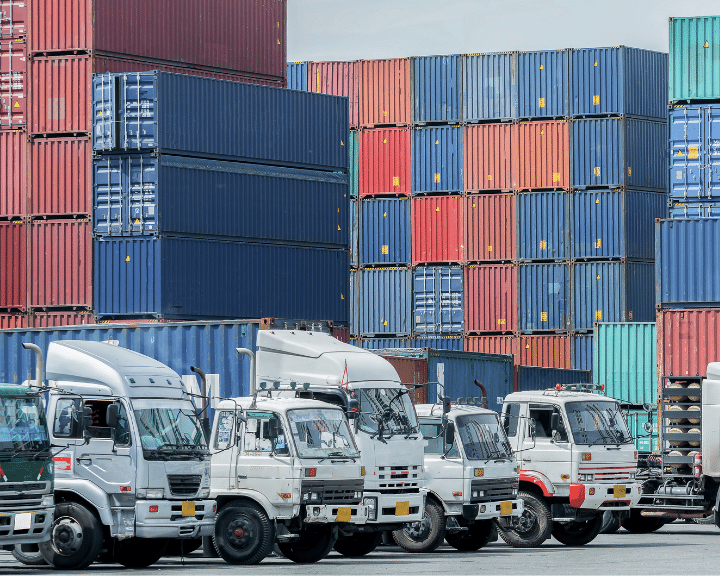Supply chain management and transportation management systems run the gamut from1980s-era systems to modern cloud platforms. Chain.io was built to integrate your TMS to any platform, regardless of the era it was built in, with ease.
TMS Integration
Modern logistics teams face a delicate balancing act as they strive to overcome logistical challenges while meeting increasingly high expectations. On the one hand, there is pressure to deliver faster, cheaper, and with fewer errors.
On the other, most supply chain data lives in silos. Order details in one system. Tracking updates in another. And financials? Those live somewhere else entirely.
This fragmentation leads to broken visibility, delayed decisions, and a significant amount of manual work. Worse, it creates a gap between how transportation actually runs and what customers expect.
That’s where transportation management system (TMS) integration comes in. When your TMS connects cleanly to your other systems—ERP, WMS, partner platforms—you get faster decisions, better outcomes, and more efficient teams.
In this article, I’ll walk through what TMS integration really means, why most companies struggle with it, and how a smarter approach can unlock real operational efficiency across your transportation network.
What is TMS integration in modern logistics systems?
TMS integration connects your transportation management system with the rest of your logistics tech stack—your warehouse management systems, enterprise resource planning (ERP) software, carrier platforms, and more. It ensures that data flows seamlessly across platforms, allowing orders, shipments, and financials to match in real-time.
This integration happens in two key ways:
- Application-to-application (A2A): Linking your internal tools like ERP and WMS.
- Business-to-business (B2B): Connecting with external partners like carriers and 3PLs.
And it uses different methods to make those connections work:
- EDI (electronic data interchange): Still standard for legacy systems.
- APIs (application programming interfaces): More modern, real-time data exchange.
Done right, TMS integration acts like connective tissue, tying together your transportation activities and making your data consistent, accurate, and timely. That’s critical for optimizing transportation strategies and meeting customer expectations.
If you're looking to better understand how these systems connect behind the scenes, check out our breakdown on integration in supply chain management that explores the different types and use cases.
The real cost of disconnected logistics operations
Many companies treat TMS integration like a one-and-done IT project. The TMS goes live, but the connections to other systems aren’t fully mapped. Data doesn’t flow right. Orders don’t match shipments. Milestones get missed.
When systems don’t talk, you see the impact fast:
- Customer service teams lack answers
- Finance teams chase down freight costs in spreadsheets
- Ops teams waste hours reconciling mismatched updates
Even when companies build their own integrations, they often break under pressure. And those breakdowns aren't always technical—they're often strategic.
A Gartner report found that 76% of logistics transformations fail to meet critical performance metrics, usually because teams treat integration as a one-time IT task rather than an evolving business capability.
Leaders who stay responsive to team feedback can improve their success rate by up to 62%. “We already built this internally” typically refers to patchwork solutions that are difficult to maintain and slow to adapt.
Without solid TMS integration capabilities, you’re left managing inventory and exceptions manually, chasing updates across disconnected tools. And that introduces risk—missed deliveries, SLA penalties, and unhappy customers.
Disconnected systems reduce fleet management efficiency, delay route planning and route optimization, and hinder cost-savings initiatives, which negatively impact fuel efficiency and delivery timelines. Instead of fueling efficiency, they introduce friction across the entire transportation process.
What an integrated TMS unlocks across the supply chain
A well-integrated TMS does more than track trucks. It connects the dots across your transportation process so your teams can operate independently, improve informed decision-making, and respond quickly to change. It enables businesses to gain valuable insights from their transportation data and better manage transportation activities, as well as efficiently manage logistics operations at scale.
To drive home that importance further, the 33rd Annual Study of Logistics and Transportation Trends found that operational disconnects and siloed data remain top concerns for logistics professionals—especially as expectations around speed and service continue to grow.
Here’s what good integration looks like in practice.
Reduced manual work and fewer errors in chain management
Clean integrations eliminate the need for rekeying and manual handoffs. Data enters once and flows where it needs to go—reducing touchpoints, minimizing errors, and freeing up time.
Real-time freight tracking and supply chain visibility
Integrated systems allow you to track shipments across your entire transportation network and monitor the full delivery process from origin to destination. That means faster updates, better exception handling, timely transmission of required customs documents, and more reliable ETAs.
Faster onboarding for partners, customers, and carriers
Pre-built connectors make it easy to plug in new systems. Whether you're expanding into new regions or bringing on a new 3PL, integration workflows are repeatable—not a custom project every time.
Improved customer relationship management
When transportation data flows directly into your CRM and order management systems, support teams stay informed. They can proactively update customers, resolve issues faster, and increase customer satisfaction.
Lower total cost of ownership across logistics systems
With automated data exchange and fewer integration tasks to maintain, your IT team can focus on higher-impact projects. That drives long-term cost savings without sacrificing reliability, helping your business save money while improving service levels. It also supports continuous improvement by enabling better analysis and refinement of key performance indicators.
How TMS integration drives competitive advantage
TMS integration isn’t just about data hygiene. It’s a strategic asset that supports growth and resilience. An overview from ScienceSoft highlights the foundational role transportation software plays in digital supply chain transformation, particularly when integrated across warehouse management systems and ERP platforms.
When transportation management software is fully connected, you gain:
- Data-driven insights: Unified data across systems enables smarter analytics, data analysis, and clearer key performance indicators.
- Agility: Teams respond faster to change—rerouting shipments, adjusting forecasts, or reacting to supplier issues.
- Scalability: As your transportation operations grow, you don’t need to rebuild the integration process every time.
It’s also the foundation for future tech, enabling businesses to act on data faster and more confidently. Clean, structured data is what feeds AI and machine learning.
As our CEO puts it, "Chain.io is the company that puts the gasoline in the AI engine."
If you're curious about how data quality impacts automation—and why it matters for your tech strategy—Chain.io has a useful overview of how integration supports collaboration across your supply chain.
The Chain.io approach: Smarter, faster integration for logistics teams
Chain.io simplifies integration for logistics teams by offering reliable TMS integrations with built-in flexibility for modern systems.
That means:
- Pre-built connectors to leading TMS systems, TMS providers, ERP systems, WMS, and carrier platforms
- Support for legacy formats like EDI, flat files, and emails
- Workflow automation that eliminates repetitive tasks and reduces overhead
- Integration lifecycle management to ensure every connection is reliable and sustainable
With Chain.io, you don’t need to rip out current systems or burn IT bandwidth. We connect your tech stack with minimal effort and keep it running smoothly behind the scenes.
Our solutions enhance seamless connection between warehouse operations, ERP systems, and TMS software. That improves operational efficiency for both IT and operations teams.
We provide a useful overview of how integration supports collaboration across your supply chain, including considerations for integrating international TMS platforms.
Connect your TMS without the complexity
TMS integration is no longer optional. To stay competitive, your logistics systems need to work as one—from planning and execution to billing and reporting. When your data flows smoothly through seamless integration, your teams work smarter, your partners get onboarded faster, and your customers stay informed.
Chain.io brings this all together. We help logistics teams connect systems quickly, avoid technical bottlenecks, and scale without friction. You get the benefit of automation, visibility, and continuous improvement—without the complexity.
Want to see how it works in your environment?
Talk to our team about simplifying your TMS integration with Chain.io.







